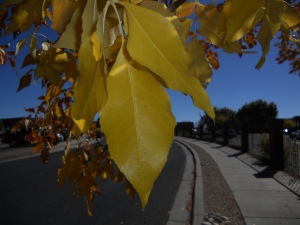Autumn is my favorite time of the year. I can’t help but take all the changes in and relish in the variances. What strikes me the most, though, is that some leaves are yellow, some are green, and some are somewhere in between. What’s even cooler to me is when one tree holds leaves at all different stages of change. Each leaf appears to be adjusting to the changing season at its own pace and in its own time.
Heck, some trees around this time of year have already lost every single leaf. Those trees seem to already be fully ready for the approaching winter. They have a headstart and will long be into their dormancy when the first snow falls. They aren’t any better than the other trees, they’re just ahead of the others.
People handle adjustments just like the leaves on the trees during autumn. Some people can adapt and respond to changes with ease and get a headstart on the new circumstance. Others need a little more time and don’t come around to the new circumstance as quickly as others do. Still, everyone adjusts differently and at their own time and pace. However, the difference between people and trees is that one tree doesn’t judge another tree for the pace at which it’s adjusting. Nor does a tree judge itself for demonstrating a mixed-bag of seasonal change readiness. Tress change as they need and don’t appear to hold any emotion about their state of readiness.
People do though. When certain events occur, we tend to think of those who adapt as “strong” while those who may not adjust as quickly as “weak.” Adjusting and adapting to life’s changes, whether we choose them or not, are as individualized as the leaves in autumn and I don’t think anyone has the right to think more or less than anyone who adjusts differently to change than we do.
What’s worse, though, is when we beat ourselves up for not being as adjusted to change as we “should be.” There’s no cut-and-dried timeline for adapting to life’s changes. Whether it’s a new job, or a move to a new city, or a new marriage; there’s a period during which we need to accept the new circumstances and understand our place within the new circumstance. Too often, I hear and see people judging themselves far too harshly for not “being happy” in their new life. They think that there’s something wrong with them because they still feel a connection to their previous life and are in a rush to get somewhere for which they may not be ready to be.
In addition to the self-talk that traps people, once a change happens, people tend to judge themselves through the lenses of self-views that may no longer be effective. What worked in one circumstance may not work in another and judging before there’s understanding almost always leads to negative feelings.
A death in a family tends to bring awareness to the individualized nature of adjusting. It’s really clear that people grieve in their own ways and no one way to grieve is either right or wrong. But other adjustments may not be so clear. But the individualized nature of adjusting remains on place, and if there is a change that was imposed, I believe with all that I am that we need to grieve what we have lost. While we shouldn’t hold on to the past, we should acknowledge its importance such that we can take from it things we can use today and tomorrow. If, however, we do not own what we feel, good and bad, we will only add to difficulty in adjusting.
Change takes time and attention to what we feel and understand. If we deny what we think and feel, there will come a day when everything we bottled up will rise up and overwhelm us. There is good in all of life’s circumstances. Sometimes, we have to process away the former situations in life before we can see the benefits to the present and future.
When all the trees are bare and all the leaves have been blown away by cold winter winds, all is equal. But, during the changing seasons, the colors are variant and pleasing to me. The process, to me, is the magic.





